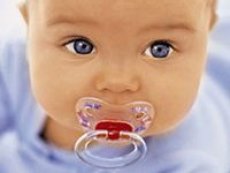Medical expert of the article
New publications
How to accustom the baby to the pacifier
Last reviewed: 08.07.2025

All iLive content is medically reviewed or fact checked to ensure as much factual accuracy as possible.
We have strict sourcing guidelines and only link to reputable media sites, academic research institutions and, whenever possible, medically peer reviewed studies. Note that the numbers in parentheses ([1], [2], etc.) are clickable links to these studies.
If you feel that any of our content is inaccurate, out-of-date, or otherwise questionable, please select it and press Ctrl + Enter.

Many mothers whose children eat too much or are too restless often ask: how to accustom a child to a pacifier? This will allow you to feel psychologically more comfortable, regulate the child's weight and feeding time, and also calm him down when he cries. Many pediatric gastroenterologists believe that sucking on a pacifier helps a child to improve the functioning of the gastrointestinal tract and the passage of gases.
Why doesn't the baby take a pacifier?
Pacifiers come in different sizes and shapes. If a baby is used to a certain configuration of mother's nipples, he may not take a pacifier that is much larger in size and density. In addition, the baby may not like the taste of the pacifier. Therefore, to accustom the baby to a pacifier, you need to use a few tricks that will help him get used to this item.
How to choose the right pacifier?
First of all, read the label: it contains recommendations regarding the age for which the pacifier is intended and the material from which it is made. This will help you choose a pacifier individually for your baby.
Pay attention to the size of the pacifier. They come in three sizes: 1, 2, 3 - for ages from birth to three months, from three months to six months, and from six months to one and a half years. But when choosing a pacifier, you need to pay attention not only to the child's age, but also to his build. If the baby is large, he may be better off with the largest or medium pacifier, rather than the smallest one.
To determine which pacifier is best for your baby, give him or her size 1, 2, and 3 pacifiers one by one. Maybe your baby likes to have his or her entire mouth full. In this case, he or she may choose pacifier number three, even though you've been constantly pushing the awkward "number one" one on him or her.
You can diversify the purpose of pacifiers, and then the baby may stop refusing it. For example, an orthopedic pacifier can be used for gnawing. Such a baby can happily suck on it when teething.
Experiment with the material the pacifier is made of. It can be latex or silicone. If the baby does not want to take the latex one, maybe he will like the silicone one.
 [ 1 ]
[ 1 ]
Folk methods of accustoming a baby to a pacifier

- If none of the methods for choosing the shape, size and purpose of the pacifier work, try a trick. Grease the pacifier with something sweet, for example, honey or jam. This simple ancient method can help very quickly - the child will take the tasty pacifier and gradually get used to it.
- You need to be very careful with honey, because it often causes allergies, especially in infants. You can lubricate the pacifier not with jam, but with mother's milk - this familiar taste can stimulate the child to suck.
- To make it more familiar for your baby to take the pacifier, you can give it to him in the position in which he usually receives breast milk.
- If you are weaning your baby, you can give him a bottle of milk, then the baby will be more accustomed to taking a pacifier - it will become a source of pleasure for him.
To properly accustom your child to a pacifier, you can consult a pediatrician. He will tell you why the child does not want to take a pacifier. The doctor can also recommend the best ways to accustom the child to a pacifier. Especially since this process is based on the most important unconditional reflex for the baby - sucking.
Why does a child need a pacifier?
It is very important to accustom the child to a pacifier if he is psychologically comfortable in the process of sucking. Without a pacifier, the child will constantly demand mother's breast. And thus take up a lot of mother's time, which will be freed up with a pacifier. And a pacifier can also be given to regulate the amount of breast milk that the child receives during the day.
- A pacifier will help out when a mother is with her child in public places. For example, in a store, pharmacy, kindergarten, on a walk, in a clinic.
- A pacifier will be useful when a small child plays in a public sandbox in the summer. Then the baby will not put everything he wants into his mouth - because he will be busy with the pacifier.
- A pacifier helps a child get used to feeding on a schedule. It is especially relevant when the child is not with his mother, but with other relatives. Statistics show that sucking a pacifier gives more psychological comfort to the baby, he becomes less restless and irritable.
- As a child grows, he increasingly tries to suck on foreign objects: fists, toys, the edge of the crib. To protect the baby from harmful bacteria, it is better to give him a boiled pacifier.
- During teething, a pacifier can be a great help because it does not cause injury to the teeth and satisfies the baby's need to chew on something.
How to accustom a child to a pacifier - parents can now decide for themselves, using our advice. Let your baby grow up healthy!

